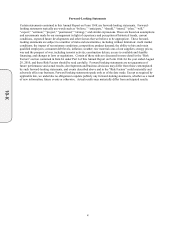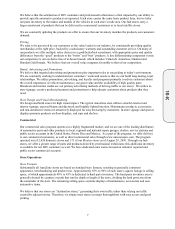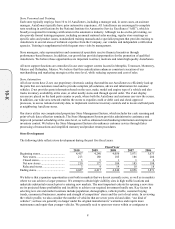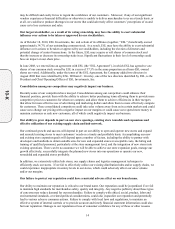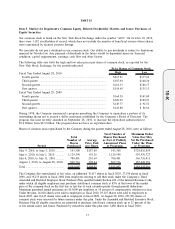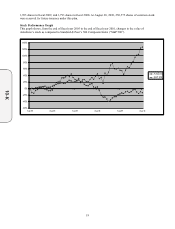AutoZone 2010 Annual Report Download - page 104
Download and view the complete annual report
Please find page 104 of the 2010 AutoZone annual report below. You can navigate through the pages in the report by either clicking on the pages listed below, or by using the keyword search tool below to find specific information within the annual report.
may be difficult and costly for us to regain the confidence of our customers. Moreover, if any of our significant
vendors experiences financial difficulties or otherwise is unable to deliver merchandise to us on a timely basis, or
at all, we could have product shortages in our stores that could adversely affect customers’ perceptions of us and
cause us to lose customers and sales.
Our largest stockholder, as a result of its voting ownership, may have the ability to exert substantial
influence over actions to be taken or approved by our stockholders.
As of October 18, 2010, ESL Investments, Inc. and certain of its affiliates (together, “ESL”) beneficially owned
approximately 34.7% of our outstanding common stock. As a result, ESL may have the ability to exert substantial
influence over actions to be taken or approved by our stockholders, including the election of directors and
potential change of control transactions. In the future, ESL may acquire or sell shares of common stock and
thereby increase or decrease its ownership stake in us. Significant fluctuations in their level of ownership could
have an impact on our share price.
In June 2008, we entered into an agreement with ESL (the “ESL Agreement”), in which ESL has agreed to vote
shares of our common stock owned by ESL in excess of 37.5% in the same proportion as all non-ESL-owned
shares are voted. Additionally, under the terms of the ESL Agreement, the Company added two directors in
August 2008 that were identified by ESL. William C. Crowley, one of the two directors identified by ESL, is the
President and Chief Operating Officer of ESL Investments, Inc.
Consolidation among our competitors may negatively impact our business.
Recently some of our competitors have merged. Consolidation among our competitors could enhance their
financial position, provide them with the ability to achieve better purchasing terms allowing them to provide more
competitive prices to customers for whom we compete, and allow them to achieve efficiencies in their mergers
that allow for more effective use of advertising and marketing dollars and allow them to more effectively compete
for customers. These consolidated competitors could take sales volume away from us in certain markets and could
cause us to change our pricing with a negative impact on our margins or could cause us to spend more money to
maintain customers or seek new customers, all of which could negatively impact our business.
Our ability to grow depends in part on new store openings, existing store remodels and expansions and
effective utilization of our existing supply chain and hub network.
Our continued growth and success will depend in part on our ability to open and operate new stores and expand
and remodel existing stores to meet customers’ needs on a timely and profitable basis. Accomplishing our new
and existing store expansion goals will depend upon a number of factors, including the ability to partner with
developers and landlords to obtain suitable sites for new and expanded stores at acceptable costs, the hiring and
training of qualified personnel, particularly at the store management level, and the integration of new stores into
existing operations. There can be no assurance we will be able to achieve our store expansion goals, manage our
growth effectively, successfully integrate the planned new stores into our operations or operate our new,
remodeled and expanded stores profitably.
In addition, we extensively utilize hub stores, our supply chains and logistics management techniques to
efficiently stock our stores. If we fail to effectively utilize our existing distribution hubs and/or supply chains, we
could experience inappropriate inventory levels in our stores, which could adversely affect our sales volume
and/or our margins.
Our failure to protect our reputation could have a material adverse effect on our brand name.
Our ability to maintain our reputation is critical to our brand name. Our reputation could be jeopardized if we fail
to maintain high standards for merchandise safety, quality and integrity. Any negative publicity about these types
of concerns may reduce demand for our merchandise. Failure to comply with ethical, social, product, labor and
environmental standards, or related political considerations, could also jeopardize our reputation and potentially
lead to various adverse consumer actions. Failure to comply with local laws and regulations, to maintain an
effective system of internal controls or to provide accurate and timely financial statement information could also
hurt our reputation. Damage to our reputation or loss of consumer confidence for any of these or other reasons
14
10-K


